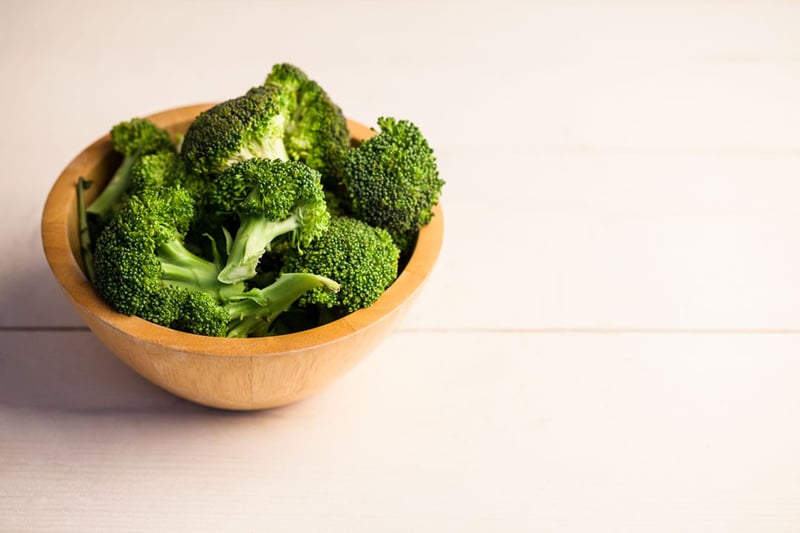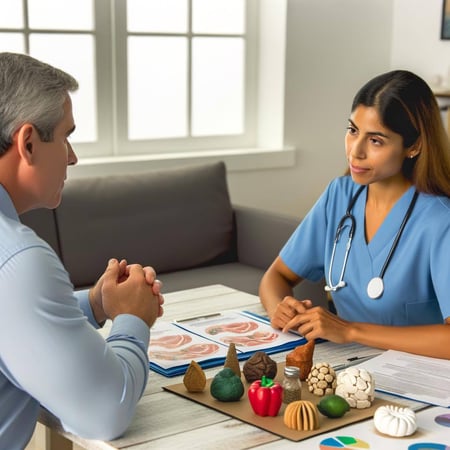
Are you taking GLP-1 receptor agonists and looking for ways to optimize their benefits through nutrition?
At OnPoint Nutrition, we understand that proper diet is not just an enhancement but an essential and necessary component of your overall treatment plan. Our team of registered dietitians and nutritionists is highly experienced in integrating advanced nutritional strategies to support your GLP-1 therapy, ensuring you achieve the best possible outcomes.
GLP-1 receptor agonists are powerful tools in managing conditions like type 2 diabetes and obesity, but their efficacy can be significantly influenced by your dietary choices. Our experts at OnPoint Nutrition are dedicated to providing you with personalized, evidence-based nutritional guidance that complements your treatment plan.
By the end of this article, you’ll gain valuable insights into key nutritional strategies specifically designed to support your GLP-1 therapy, helping you achieve optimal health and wellness.
The Role of Diet in GLP-1 Therapy
A well-balanced diet plays a crucial role in the success of GLP-1 receptor agonist therapy. Proper nutrition is not only an enhancement but a necessary component to maximize the benefits of this medication.
Here's how a well-balanced diet can significantly improve the outcomes of GLP-1 receptor agonists by supporting overall health, promoting weight loss, and managing side effects:
1. Supporting Overall Health:
- Nutrient-Rich Foods: Consuming a variety of nutrient-dense foods ensures that your body receives essential vitamins and minerals that support overall health. This includes plenty of fruits, vegetables, whole grains, lean proteins, and healthy fats.
- Improved Metabolic Function: A balanced diet helps regulate metabolism, which can enhance the body's response to GLP-1 therapy. Proper nutrition aids in maintaining stable blood sugar levels, reducing the risk of diabetes-related complications.
- Strengthening Immune System: Eating a diet rich in antioxidants, vitamins, and minerals strengthens the immune system, making it easier for your body to handle the demands of GLP-1 therapy and fend off illnesses.
2. Promoting Weight Loss:
- Calorie Control: A well-planned diet helps control calorie intake, which is essential for weight management. Reducing excess calories while ensuring nutritional adequacy can lead to sustainable weight loss, a key benefit of GLP-1 therapy.
- Satiety and Fullness: High-fiber foods and balanced macronutrients help increase feelings of fullness and satiety, reducing the likelihood of overeating. This complements the appetite-suppressing effects of GLP-1 receptor agonists.
- Healthy Eating Habits: Establishing and maintaining healthy eating habits through structured meal plans and mindful eating techniques can prevent weight gain and support long-term weight loss goals.
3. Managing Side Effects:
- Gastrointestinal Comfort: Some individuals may experience gastrointestinal side effects, such as nausea and diarrhea, when starting GLP-1 therapy. A dietitian can recommend specific foods and meal patterns that are easier on the digestive system and help alleviate these symptoms.
- Blood Sugar Stability: Consuming balanced meals with a low glycemic index helps stabilize blood sugar levels, reducing the risk of hypoglycemia and hyperglycemia. This is particularly important for individuals managing diabetes with GLP-1 receptor agonists.
- Hydration and Electrolyte Balance: Ensuring adequate fluid intake and maintaining electrolyte balance can help manage side effects like dehydration and dizziness. Drinking plenty of water and incorporating hydrating foods into your diet is crucial.
4. Enhancing Medication Efficacy:
- Synergistic Effects: Combining GLP-1 therapy with a well-balanced diet creates a synergistic effect that enhances the medication's efficacy. Proper nutrition supports the body's natural processes and improves the overall response to the medication.
- Improved Adherence: Patients who follow a structured, nutritious diet often find it easier to adhere to their medication regimen. This consistency can lead to better health outcomes and a more effective treatment experience.
- Tailored Nutritional Strategies: Dietitians can tailor nutritional strategies to individual needs, ensuring that each person receives the right balance of nutrients to support their specific health conditions and treatment goals.
Key Nutritional Strategies
Optimizing your GLP-1 therapy involves implementing key nutritional strategies that support your overall health and enhance the effectiveness of your treatment. Here are essential strategies to focus on:
1. Balanced Macronutrients:
- Proteins: Incorporating high-quality proteins into your diet is crucial for maintaining muscle mass, repairing tissues, and supporting metabolic functions. Sources include lean meats, poultry, fish, eggs, dairy products, legumes, nuts, and seeds. Proteins also play a role in satiety, helping you feel fuller for longer and reducing the likelihood of overeating.
- Fats: Healthy fats are essential for brain health, hormone production, and the absorption of fat-soluble vitamins (A, D, E, and K). Focus on unsaturated fats from sources like avocados, olive oil, nuts, seeds, and fatty fish such as salmon and mackerel. These fats can help improve heart health and support overall well-being.
- Carbohydrates: Carbohydrates provide the primary source of energy for your body. Choose complex carbohydrates that are rich in fiber and nutrients, such as whole grains, fruits, vegetables, and legumes. These foods help maintain stable blood sugar levels and provide sustained energy throughout the day.
2. Fiber Intake:
- Soluble Fiber: Soluble fiber dissolves in water to form a gel-like substance that helps regulate blood sugar levels and lower cholesterol. Foods rich in soluble fiber include oats, barley, beans, lentils, apples, and citrus fruits. This type of fiber also aids in digestion and promotes a feeling of fullness.
- Insoluble Fiber: Insoluble fiber does not dissolve in water but adds bulk to the stool, promoting regular bowel movements and preventing constipation. It is found in whole grains, nuts, seeds, and vegetables such as carrots, celery, and green beans. Incorporating both types of fiber into your diet ensures a well-rounded approach to digestive health.
3. Hydration:
- Adequate Water Intake: Staying hydrated is vital for overall health and the effectiveness of GLP-1 therapy. Water is essential for digestion, nutrient absorption, and the removal of waste products from the body. Aim to drink at least 8 cups (64 ounces) of water daily, or more if you are physically active or live in a hot climate.
- Hydrating Foods: In addition to drinking water, consume foods with high water content, such as cucumbers, lettuce, watermelon, strawberries, and oranges. These foods contribute to your daily hydration needs and provide essential vitamins and minerals.
- Electrolyte Balance: Maintaining a balance of electrolytes, such as sodium, potassium, calcium, and magnesium, is important for proper muscle function and fluid balance. Include foods like bananas, spinach, yogurt, and nuts in your diet to ensure adequate electrolyte levels.
4. Nutrient Timing and Portion Control:
- Meal Timing: Eating regular, balanced meals throughout the day helps maintain stable blood sugar levels and supports your body's natural rhythms. Avoid skipping meals, as this can lead to overeating later and disrupt blood sugar control.
- Portion Control: Practicing portion control ensures you consume the right amount of calories and nutrients without overeating. Use smaller plates, measure servings, and be mindful of portion sizes, especially with high-calorie foods. This strategy helps in weight management and enhances the effectiveness of GLP-1 therapy.
- Mindful Eating: Pay attention to your body's hunger and fullness cues. Eating slowly and savoring your food can help you avoid overeating and make healthier food choices. Mindful eating also promotes better digestion and overall enjoyment of meals.
5. Limiting Processed Foods and Sugars:
- Reducing Processed Foods: Processed foods often contain high levels of unhealthy fats, sugars, and sodium, which can negatively impact your health and the effectiveness of GLP-1 therapy. Focus on whole, unprocessed foods that provide essential nutrients without added chemicals and preservatives.
- Cutting Back on Added Sugars: High sugar intake can lead to spikes in blood sugar levels and contribute to weight gain. Limit sugary snacks, beverages, and desserts, and opt for natural sources of sweetness, such as fruits, when craving something sweet.
Foods to Include:
- Lean Proteins: Chicken, fish, tofu, and legumes to support muscle maintenance and satiety.
- Healthy Fats: Avocado, nuts, seeds, and olive oil for hormone production and nutrient absorption.
- Complex Carbohydrates: Whole grains, fruits, and vegetables for sustained energy and fiber.
Meal Timing and Frequency:
- Regular Meals: Eat at regular intervals to maintain stable blood sugar levels and avoid overeating.
- Small, Frequent Meals: This can help manage side effects like nausea and maintain energy levels throughout the day.
The Role of a Virtual Registered Dietitian in GLP-1 Nutrition
Optimizing your diet is not just a way to enhance the benefits of GLP-1 receptor agonists; it's a vital component of achieving your weight loss and overall health goals. Proper nutrition supports the medication's effectiveness, aids in managing side effects, and contributes to sustainable, long-term health improvements. However, navigating dietary changes and understanding how to balance nutrients effectively can be challenging without professional guidance.
This is where the indispensable role of a dietitian comes into play. Dietitians are experts in nutrition and are uniquely qualified to provide the personalized advice and support you need to make the most of your GLP-1 therapy. Here’s how a dietitian can make a significant difference in your health journey:
1. Personalized Nutritional Assessment: A dietitian will conduct a thorough assessment of your current diet, lifestyle, and health status. They will identify your unique nutritional needs and create a tailored plan that aligns with your GLP-1 therapy and personal goals.
2. Customized Meal Planning: Creating a balanced diet that meets your needs requires expertise. Dietitians provide customized meal plans that ensure you receive the right balance of macronutrients and micronutrients. They can help you incorporate fiber-rich foods, maintain proper hydration, and manage portion sizes effectively.
3. Managing Side Effects: GLP-1 receptor agonists can sometimes cause gastrointestinal side effects. A dietitian can recommend specific dietary adjustments to mitigate these issues, making your treatment more comfortable and effective. They can guide you on foods that are easier to digest and offer strategies to manage symptoms like nausea and diarrhea.
4. Ongoing Support and Monitoring: Achieving and maintaining dietary changes can be challenging. Dietitians offer continuous support, monitoring your progress and making necessary adjustments to your meal plan. Regular check-ins ensure you stay on track and address any challenges you encounter.
5. Education and Empowerment: Dietitians educate you about the importance of various nutrients, helping you make informed food choices. They empower you with knowledge and skills to sustain healthy eating habits long-term, beyond your GLP-1 therapy.
6. Holistic Health Approach: A dietitian considers all aspects of your health, integrating nutrition with other lifestyle factors such as physical activity and stress management. This holistic approach ensures comprehensive care and maximizes the overall benefits of your treatment.
7. Evidence-Based Recommendations: Dietitians stay up-to-date with the latest research and advancements in nutrition science. Their recommendations are evidence-based, ensuring you receive the most effective and scientifically-backed advice.
8. Enhanced Treatment Outcomes: With a dietitian’s guidance, you can optimize your diet to significantly enhance the outcomes of your GLP-1 therapy. This includes better weight management, improved blood sugar control, and overall enhanced well-being.
For personalized nutritional advice and expert meal planning, contact OnPoint Nutrition today. Our team of dedicated dietitians is here to support you every step of the way. Let us help you succeed on your health journey, ensuring you achieve the best possible outcomes from your GLP-1 therapy.
Together, we can create a balanced, healthy diet that empowers you to reach your goals and maintain long-term health and wellness.

With a knack for turning complex nutrition facts into engaging, relatable content, she’s on a mission to make healthy living fun and accessible. Backed by a stellar team of Dietitians and Nutritionists, Abby breathes life into OnPoint’s mission, inspiring others to embrace the transformative power of good nutrition. Her infectious enthusiasm and innovative approach make her a driving force in the journey towards better health for all.




